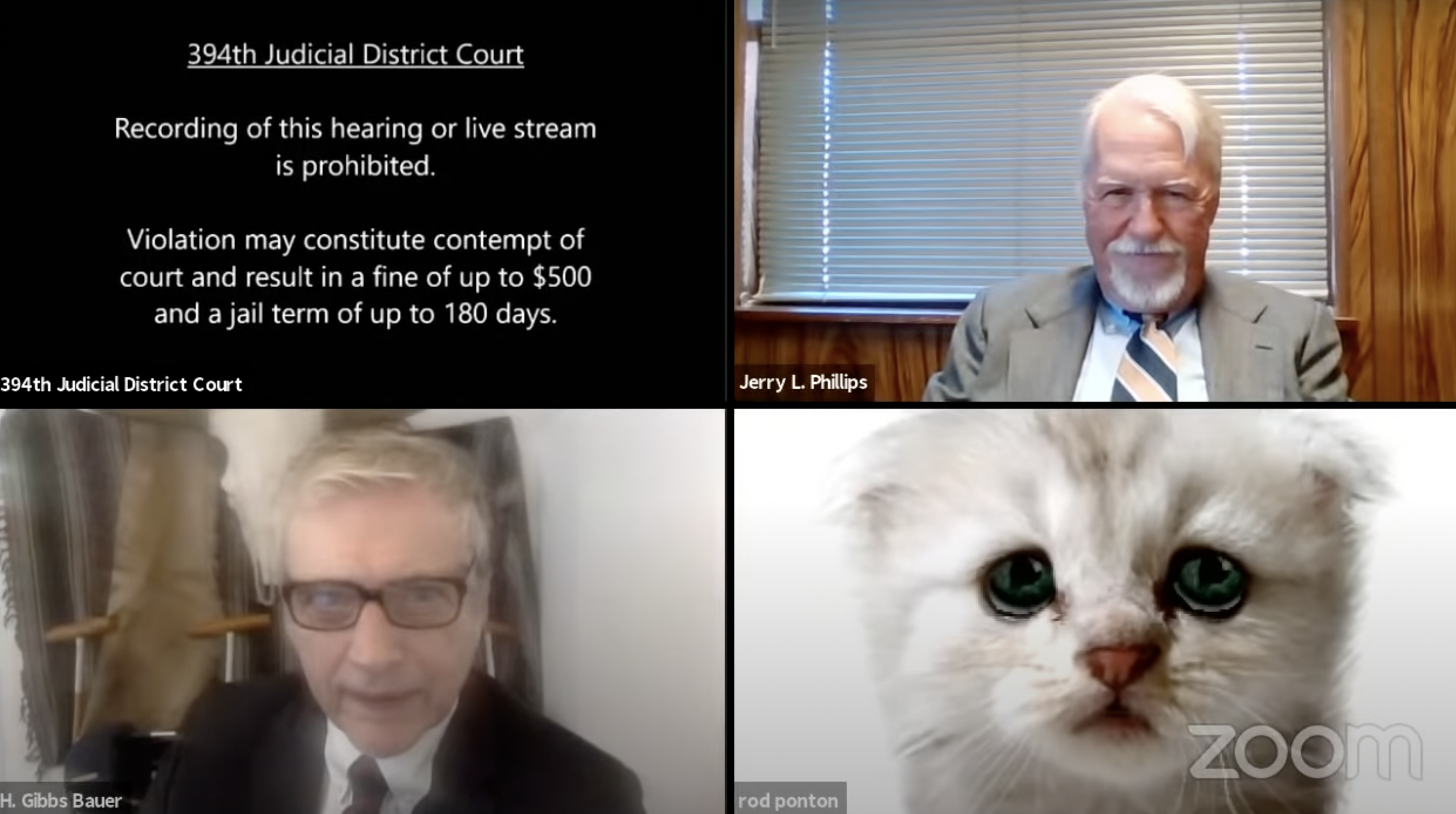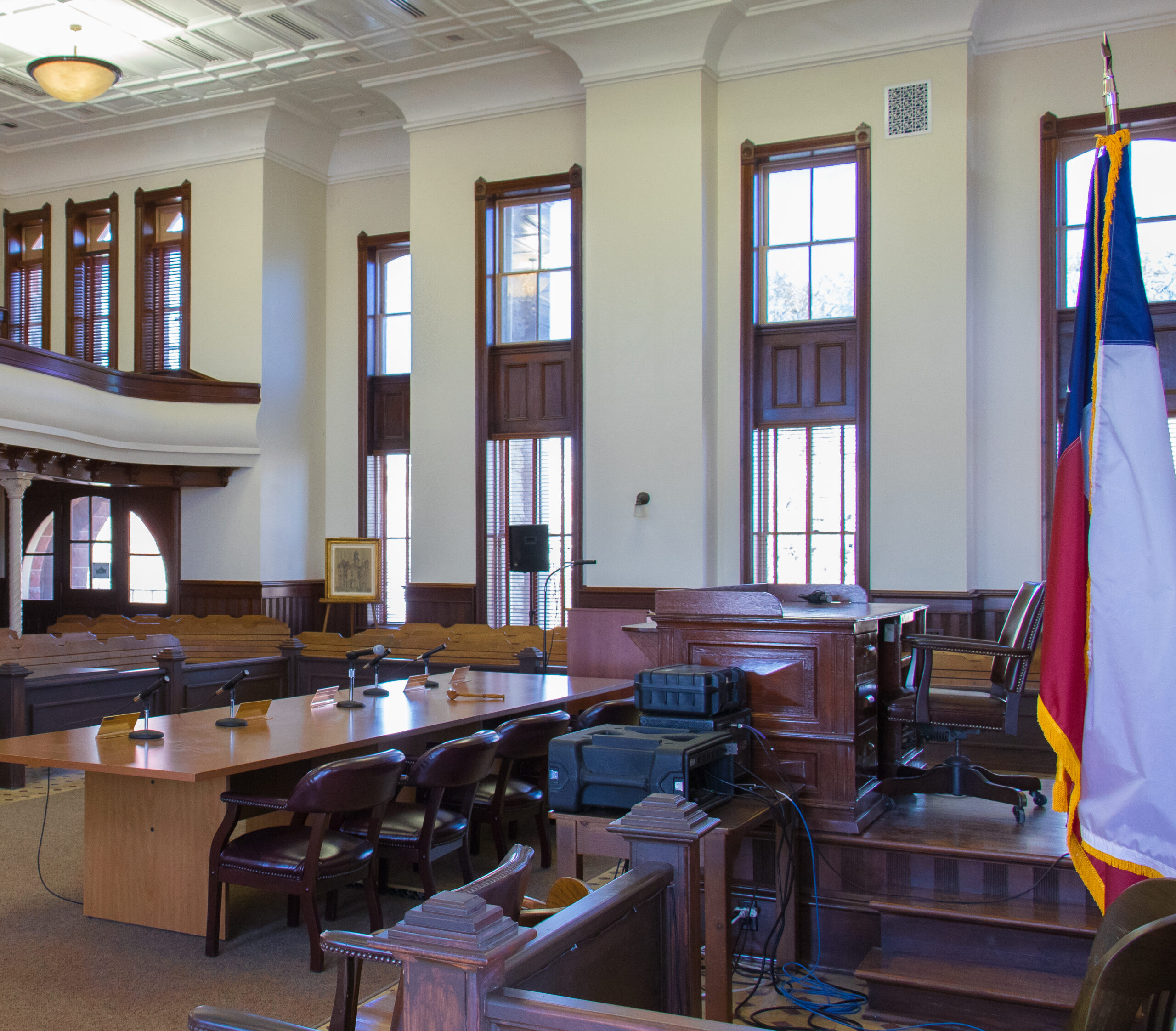
How Texas Courts Went Virtual
The administrator responsible for moving hearings online during the COVID-19 pandemic talks about the future of Zoom court.

Above: During a virtual hearing on February 9 in Texas’ 394th Judicial District Court, attorney Rod Ponton got stuck using a cat filter on Zoom.
In a West Texas district court Zoom hearing on Tuesday, an unexpected face joined the meeting: a cat. Or, more accurately, 69-year-old Presidio County Attorney Rod Ponton, trapped in a virtual filter. His face replaced with the countenance of a somber feline, the lawyer assured the judge, “I’m here live; I’m not a cat.”
The internet exploded with laughter. But as Texas courts have transitioned online due to the COVID-19 pandemic, there are serious concerns and opportunities regarding access to justice. David Slayton is the man in charge of moving Texas court hearings online during the COVID-19 pandemic. The administrative director for Texas’ Office of Court Administration, Slayton has wrangled judges and lawyers across the state for more than one million remote hearings, including the first virtual jury trial in the country. Slayton says more people are showing up to their court dates than ever before. Still, advocates worry that low-income and rural defendants, particularly those without reliable broadband access, will suffer from online trials—especially in high-volume courts like justices of the peace, which oversee eviction proceedings. In some cases, one party might be in person while the other appears virtually. Overall, the number of trials in Texas has plunged in the past year, leaving a hefty backlog.
Slayton spoke with the Observer in January about Zoom courts, access to justice, and the future of the Texas court system.
Texas Observer: Take me through the process of transitioning the courts online.
David Slayton: [Last] February, we were getting information about what the [COVID-19] situation looked like and the fact that we should begin to prepare. We had some internal conversations with the [Texas] Supreme Court and with the Court of Criminal Appeals—our two high courts. How are we going to respond? What should we do? March 13th is when the governor declared a disaster. Within four hours, the Supreme Court and the Court of Criminal Appeals issued an emergency order, which authorizes judges to hold remote hearings using video conferencing technology, and to do that without getting the consent of the parties.
We procured 3,000 licenses to Zoom because that’s how many judges we have in the state. We trained the judges and started issuing licenses. We look at March 24th as Day One, even though there was a little bit of remote hearings going on the previous week. It’s been a pretty remarkable journey. Every type of hearing and every type of case at every level of court has occurred remotely, whether it be just a normal status conference or a motion hearing, a bench trial, or even jury trials.
How does Texas’ Zoom court process compare to other states?
We were the first to really go all in back in March. There are other states that are right there with us, but I would say we’re the leader overall, in the number of hearings held, the number of courts doing it, the type of proceedings. We’ve done more virtual jury trials than all the [other] states combined at this point.
What has the reception been?
As with everything, change is hard and technology is somewhat difficult. But I was actually amazed at how quickly our judges embraced this. [Judges were] faced with the option of: It could be months, perhaps years, before people could get into court physically, versus if you can do this electronically and we can do it remotely, we can do it next week.
Some advocates say that Zoom trials are actually limiting access to a fair trial.
That was certainly a concern of all of us when we first began. One of the questions, and we don’t know the answer to this: Is there any impact on rulings? I think if you talk to judges, judges would say no, this might have made it better. Judges report things like some litigants or attorneys being overrun by other more assertive attorneys. But because of the way that Zoom works, it’s hard to talk over somebody or to interrupt them.
Between I-35 and El Paso, there’s very, very few [licensed] interpreters. Now you can be an interpreter anywhere in the state, anywhere in the world, and you can hop on a remote hearing.
I think what we’ve seen is that, in some ways this has leveled the playing field a little bit.
So much of Texas doesn’t have access to broadband. Has internet access been an issue?
We were afraid it would be, but we’ve not actually seen it. Some of our judges have to go to the courthouse because they don’t have sufficient broadband connection at their home to be able to connect throughout the day. Some clients or defendants or parties have had to go to the courthouse or go to the lawyer’s office or go to public libraries to be able to participate. Every now and then someone needs to participate via phone because they don’t have access to video.
There’s a question in my mind—again, some research is necessary—whether or not jury selection should continue to be remote. What we’ve seen in the [more than 25 virtual jury trials] we’ve had so far is that every one of those, there’s been increased participation. Usually, let’s say that a county has 40 percent of people show up for jury duty—that’s actually a pretty good number. During the pandemic, that’s declined to 30, 35, maybe 25 percent of people showing up [in-person]. With the virtual jury selection, we’ve seen that number actually increase, so, 60, 70, 80 percent participation.
So is Zoom court here to stay?
Yes. The more complicated the case is, the more likely it is that it might happen best in person. But there’s definitely a lot of things that can happen remotely and we expect it to stay remote. The Judicial Council, which is the policy-making body for the judicial branch, has actually passed a resolution calling on the Legislature and the [Texas] Supreme Court to amend the statutes or rules as necessary to remove all barriers to giving judges the discretion to continue having remote hearings after the pandemic.
If you look at it from the judge’s perspective, there are a lot who have to travel. We have a judge in West Texas who travels four hours each day. Now, of course, they can log on and have that hearing without the four hours of travel.
If you look at it from the attorney’s perspective, many attorneys have to leave their office, go down to the courthouse, find parking, go wait in the courtroom for maybe maybe a couple hours to get to their 15, 20 minute hearing. Obviously very costly to them as business owners and maybe not the best, efficient use of time.
And if you look at it from the litigant’s side, one of the interesting things that we’ve seen nationwide is that the number of people not showing up to their court hearings has significantly declined. When people don’t show up to court hearings, bad things happen. They either get a warrant issued for their arrest or they get a default judgment against them. We’ve seen increased appearance rates, which obviously is a good thing.
We’ve had long-haul truck drivers pulling over, appearing from the side of the road. We’ve had people appearing from break rooms of their workplaces. We’ve had people appearing in their homes where the children are in the other room, but they wouldn’t otherwise have had child care or they wouldn’t have had transportation.
This interview has been edited for length and clarity.
Read more from the Observer:
-
Editorial: Texas Wasn’t Prepared for the Statewide Vaccine Rush
My elderly parents’ experience getting the COVID-19 vaccine highlights problems with Texas’ overall pandemic response. -
What to do With a “Tidal Wave” of Texas Wind Turbine Blades: The wind energy industry is struggling to find sustainable solutions for fast-accumulating piles of dead wind turbine blades. So far, all the options come with an environmental price.
-
In ‘At the Ready,’ Latinx High Schoolers Train to Be Border Patrol Agents: A new documentary tells one story of the border through three conflicted young Texans’ job prospects, and the result is emotional, relational, and hard to categorize.


